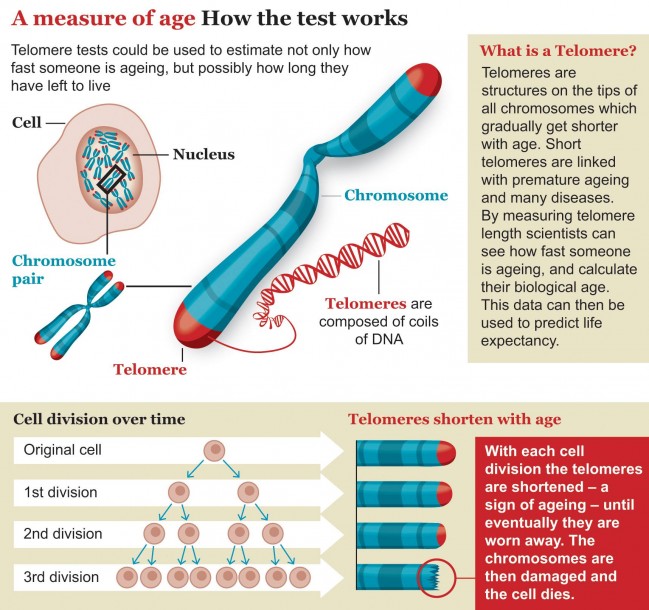In 1977 Elizabeth Blackburn and Joseph Gall, molecular biologists, discovered the structure of the end caps, known as telomeres, of chromosomes. In 2009, Blackburn and colleagues Carol Greider and Jack Szostak shared the Nobel prize in Physiology or Medicine for discovering the enzyme telomerase, the enzyme responsible for replenishing telomeres.
It turns out that telomeres are rather important. Studies shows that telomeres regulate cell division, and as a consequence directly influence aging and life span. When a cell divides the length of its chromosomal telomeres shortens. Once a telomere is depleted its chromosome, and DNA, can no longer be replicated accurately, and the cell no longer divides, hastening cell death.
[div class=attrib]From the Independent:[end-div]
A blood test to determine how fast someone is ageing has been shown to work on a population of wild birds, the first time the ageing test has been used successfully on animals living outside a laboratory setting.
The test measures the average length of tiny structures on the tips of chromosomes called telomeres which are known to get shorter each time a cell divides during an organism’s lifetime.
Telomeres are believed to act like internal clocks by providing a more accurate estimate of a person’s true biological age rather than their actual chronological age.
This has led some experts to suggest that telomere tests could be used to estimate not only how fast someone is ageing, but possibly how long they have left to live if they die of natural causes.
Telomere tests have been widely used on experimental animals and at least one company is offering a £400 blood test in the UK for people interested in seeing how fast they are ageing based on their average telomere length.
Now scientists have performed telomere tests on an isolated population of songbirds living on an island in the Seychelles and found that the test does indeed accurately predict an animal’s likely lifespan.
“We saw that telomere length is a better indicator of life expectancy than chronological age. So by measuring telomere length we have a way of estimating the biological age of an individual – how much of its life it has used up,” said David Richardson of the University of East Anglia.
The researchers tested the average telomere lengths of a population of 320 Seychelles Warblers living on the remote Cousin Island, which ornithologists have studied for 20 years, documenting the life history of each bird.
“Our results provide the first clear and unambiguous evidence of a relationship between telomere length and mortality in the wild, and substantiate the prediction that telomere length and shortening rate can act as an indicator of biological age further to chronological age,” says the study published in the journal Molecular Ecology.
Studying an island population of wild birds was important because there were no natural predators and little migration, meaning that the scientists could accurately study the link between telomere length and a bird’s natural lifespan.
“We wanted to understand what happens over an entire lifetime, so the Seychelles warbler is an ideal research subject. They are naturally confined to an isolated tropical island, without any predators, so we can follow individuals throughout their lives, right into old age,” Dr Richardson said.
“We investigated whether, at any given age, their telomere lengths could predict imminent death. We found that short and rapidly shortening telomeres were a good indication that the bird would die within a year,” he said.
[div class=attrib]Read the entire article following the jump.[end-div]
[div class=attrib]Infographic courtesy of Independent.[end-div]

